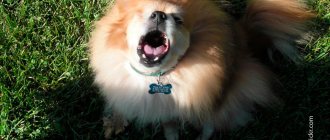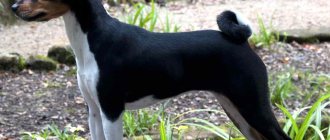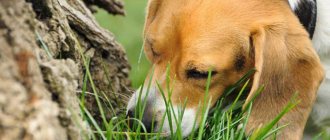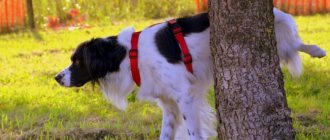A dog cannot help but bark, because barking is one of the important communications of dogs, with the help of which they express their emotions. Different dogs bark at different frequencies and for different reasons. Some of these reasons are liked by their owners, and some are not.
Even at the stage of choosing a breed, it makes sense to find out its tendency to bark and decide whether it is suitable for you. If you (or your neighbors) like silence, purchasing a Spitz or Beagle would not be the best solution. However, do not forget that even the most silent breed, if not properly raised, can acquire the bad habit of barking for any reason. As well as vice versa, proper upbringing can turn a representative of a talkative breed into a worthy city dweller and a favorite of the neighbors.
You can learn more about all existing types of barking, what function they perform and what to do with them, in the book by Tyurid Rugos “Barking - what do dogs talk about?” .
Here I will discuss only the most common problem barking , which can arise due to improper upbringing, and ways to prevent it.
Major Behavior Problems
- home
- Major Behavior Problems
The main cause of behavioral problems in Russells is a lack of physical and mental activity.
They need constant work or play to keep their body and mind occupied. Ignoring this rule may result in your pet becoming an unpredictable animal whose pent-up energy will one day explode into destructive behavior. Just like many people, Russell likes to have his own schedule. Something your Russell will look forward to.
It's a good idea to let your pet follow you around the house, as if glued to it, while you do routine things - make the bed, wash clothes, go to the store. For each new chore, come up with new commands for him to learn. For example, when you are going to sweep the kitchen floor, train Russell to fetch you the dustpan. Very soon you will find that he has become useful in carrying out the household chores, and he will be happy because he will be doing what he was born to do - working alongside his owner.
Let's look at the most common problems in the behavior of Jacks, which cause their owners a lot of trouble. All difficulties, of course, can be corrected or even prevented from occurring through proper education and training. Rest assured: there is no such thing as incorrigible behavior; there are lazy owners who simply don’t have the time to train their pet.
Barking with excitement.
This barking occurs in situations of strong excitement: when a doorbell rings or knocks, guests arrive, or when going for a walk or play. And also before hunting, coursing, harness racing and other exciting activities.
This barking does not have any independent function, but is a symptom of the dog’s internal state.
The main problem here is that the events that cause this excitement also reinforce it. Going out for a walk with a dog jumping and barking with excitement about the walk reinforces this emotional state and the behavior that follows from it.
It will be easier for you to correct this type of barking if you remove the rose-colored glasses of the “agitation = joy” myth. At these moments, the dog is stressed to the limit, and physical activity helps him cope with this discomfort. Believe me, as a person with panic attacks, who on my first plane flight spent an hour running up and down the aisle to somehow alleviate my condition. She's not happy at all!
Stubbornness
Stubbornness certainly stems from the origin of the breed. The Jack Russell Terrier is a self-sufficient dog that knows how to make decisions, take responsibility, take risks, and insist. Every time he hears this or that command from you, Jack assesses the situation, as if thinking for a moment: “Should I accept your rules of the game? Is this or that action necessary?” He not only obeys you unconditionally, but decides whether he needs it. It seems to you that he is stubborn and refuses to obey. If you have an adult Jack who weighs your every command, this means that since childhood you have not been able to establish your dominance over him as the leader of the pack. To prevent stubbornness, build a relationship with the puppy from the very first days, as with an adult dog, develop obedience skills in the puppy, teach it commands, without waiting for it to grow up.
History of the Jack Russell Terrier breed
There are breeds that have lived side by side with humans for so long that it is only possible to reliably learn about their roots with the help of geneticists.
This is, for example, the situation with the ancestors of Jack Russells - fox terriers. Their first descriptions are found in Roman chronicles from the time of Caesar’s campaigns against Albion. But the closer we get to modern times, the more documentary evidence there is, so today no one doubts that the Jack Russell Terrier owes its appearance to a very specific enthusiast - John “Jack” Russell. Following family tradition, he became a priest and headed a small parish in the south of Britain, but this man’s true passion remained not serving the church, but parfors hunting and breeding dogs for it.
Even in John's last year of study at Exeter College, Oxford University, a significant meeting took place. During one of his walks, he saw a dog that embodied the ideal qualities of a real fox hunter: compact size, passion, vigilance and fearlessness. The treasure belonged to a local milkman, who was unlikely to be able to fully appreciate the mentioned advantages, so the first owner immediately gave Trump up to a persistent student. With this Trump - this is how the English word Trump is translated - many years of selection work began.
Of course, outwardly, the ancestor of the breed does not look so much like the current “Jacks”. The similarity is noticeable only in color: against the dominant white background, darker spots stood out in the area of the eyes, ears and at the base of the hook-shaped tail. Judging by the surviving drawings, Trump was a poor-boned dog with a small skull. Most likely, her family included the now extinct English White Terriers.
It must be said that in the process of breeding a new breed, the pastor used representatives of various burrow dogs. There is no exact data about experiments with the gene pool, since the breeder did not keep any journals with records, or they simply did not survive. Researchers believe that fox terriers of the old format, border dogs, lakelands, Irish terriers, and Scottish cairns left their mark on the formation of the breed. Russell set himself the task of improving the working qualities of the offspring, and he did not consider it necessary to cull puppies because of the shape of the skull or the position of the tail. As a result, the unsightly and roughly cut short-legged pets of the Devonshire priest won the ardent love of all the surrounding hunters.
Although the vicar himself was involved in boxing (which in the 19th century was a very tough sport, because protective gloves were not used), he was not prone to cruelty and publicly condemned those fellow breeders who mixed the blood of fighting dogs into terriers. For John, fox hunting was incompatible with killing or severely injuring prey; he considered the main goal to be a competition between foxes and his animals in speed and endurance. Russell's terriers did not require the ferocity and powerful jaws of a bulldog.
The pastor's achievements in breeding and popularizing terriers did not go unnoticed. In 1873, he, along with Sewallis Shirley and a dozen like-minded people, took part in the creation of the organization that is today known as the oldest kennel club - the English Kennel Club. In subsequent years, John Russell was invited as a judge to exhibitions, but did not exhibit his own pets, calling them wild rose hips against a background of greenhouse roses. And this comparison was not in favor of the latter.
John Russell, who devoted much of his life to dog breeding, died at the age of 87 and was buried in the village of Swimbridge - in the cemetery next to the medieval church of St. James, where he served. Since he actively sold puppies and adult dogs, at the time of his death the breeder had only 4 dogs.
The development of the breed was continued by a young colleague, Arthur Heinemann. He is the author of the first draft of the breed standard. In 1914, the Parson Jack Russell Terrier Club (parson means “priest”) was founded and existed until the 40s. In the middle of the century, Russell's terriers began to be crossed with dachshunds and Welsh corgis to improve their character and working qualities. As a result, not only “classic” animals, but also short-legged animals began to appear. The latter were considered undesirable for a long time and in the eyes of the jury invariably lost to their tall brothers.
It is unknown what the fate of the “side branch” would have been if, in the 1960s, several dogs with short legs had not ended up on the Green Continent. The Australians, of course, did not intend to hunt with them, but they appreciated the energy and intelligence of their new pets, so they took up the development of the breed with great enthusiasm.
Official recognition by the Kennel Club and the FCI came only in 1990. Then both types of dogs were included in the standard of the International Canine Organization under the general name Parson-Jack Russell Terrier. However, activists from the UK and Australia did not give up attempts to achieve differentiation, and in 2001 two standards were adopted: for the Parson Russell Terrier (animals with long legs with a square body) and the Jack Russell Terrier (short legs with an elongated body).
Chewing
Dogs love to chew. During childhood, they chew due to changing teeth. Adults chew because they enjoy the process itself. Of course, you wouldn't want your Jack's chewing item to be shoes or furniture. Provide your puppy with suitable chewing toys, as well as special chewing bones, there are plenty of them in pet stores. And try to limit Jack's access to shoes (just put them away). If the terrier does chew your shoe, do not yell at him. Distract his attention with a toy, and when he starts chewing it, praise him. And be generous with your praise.
What can you do to prevent your puppy from developing the bad habit of barking for any reason?
Follow the "golden principle". Reward the puppy for silence and do not reward for barking. It's simple. Teach him an alternative calm behavior instead of the old noisy one.
In the case of demanding barking, a good option would be to sit silently - an analogue of our “please”. Agree that hearing “please” is much more pleasant than “hey, come on!” Teaching your puppy to say “please” is very easy, especially if he already knows how to sit. Just show him a piece of treat and wait for him to stop putting his paws on you, jumping and barking and sit down, looking at you. Give him a piece. When he immediately sits down for a piece, do the same with toys, asking him to be held in your arms (or sofa), before putting down a bowl of food, and for everything else that he so wants to receive. And very soon the moment will come when, in any incomprehensible situation, he will sit down, politely asking you to fulfill his request.
The same polite request “please” can also be used in the case of barking from excitement . Only here the reward will not be a material object, but an exciting event. Teach your puppy to sit (not jump and bark) to greet you when you come home from work. Teach him to sit down when guests come to you. Teach him to sit before you attach the leash and go for a walk. Here you may have to try a little more. When he is active, simply freeze like a statue and wait until he sits down again on his own (without your prompting) before continuing your actions. Think of it as a game: at one point in time, either people or dogs can move. If the puppy freezes (sits), people move; if the puppy moves (jumps up), people freeze. If you teach him to remain calm in the face of all sorts of exciting events, you will not be in danger of hearing barking due to excitement.
Be sure to provide your puppy with “good” entertainment, even when you are at home. Chew toys and search games are good options. When a puppy chews and sniffs, he cannot bark, and the pleasure he receives from getting food serves to reinforce silence. According to Ian Dunbar, feeding a puppy his entire daily diet through Kongs can reduce barking by 90%!
And, of course, make sure that neither you, nor other people, nor the environment reward the puppy for barking. Invite only those friends who are able to control themselves and not interact when meeting a puppy until he sits down politely, and also not pay attention to possible demanding barking.
Anxiety from loneliness
One explanation for unwanted behavior in the Jack Russell Terrier is separation anxiety. This happens to both adult terriers and puppies. When you bring a puppy into your home, you separate him from his brothers and sisters. He is not used to being alone, without the company of his littermates and his mother. It's natural to expect him to cry and whine from loneliness, especially when you leave home. In order to distract himself with something, in this state Jack can chew furniture, baseboards, shoes, dig up the upholstery, leave puddles and piles, whine and howl. He behaves this way not because he specifically wants to misbehave or punish you. It's just his way of expressing his fear that you might not return to him. Likewise, an adult Jack may suffer from loneliness if this phobia has been ingrained since puppyhood. His destructive behavior can cause even more damage to the apartment, given the strength of his paws and adult teeth. And his loud barking or howling will cause a lot of trouble for the neighbors. Why? Yes, because Jack is trying to get out of the house and find you. He takes active steps to achieve his goal. When you get home and see a mess made, your first impulse is to punish your pet. But this is the most wrong thing you can do. Because in this case, your Jack will wait with horror for your return, but at the same time he will not stop worrying about your departure and making a mess - so you are in a vicious circle.
Territory protection
In this case, the dog barks at anyone who violates its territory. Any attempt by strangers to get into the yard, house, or come too close to the place where she is resting can cause such a reaction. The bark is low, short, intermittent and often accompanied by a growl.
An animal that is defending itself or its environment may attack if its warning is not responded to.
During your absence, as well as at night, a dog locked at home or in its enclosure will not be responsible for guarding the yard and should sleep most of the time.
Fear of loud noises
Many Jacks, and dogs in general, are afraid of loud bangs, fireworks, and thunder. Usually, everyone has these fears in childhood, but they disappear with age. If your puppy is afraid of loud noises, do not show concern or try to calm him down. The moment you see your pet's fear, call him to you, pet him, praise him. But under no circumstances should you calm him down or pick him up. Let him see that you are calm and do not show excitement. One of the most important skills that you should teach your Jack from childhood: in a stressful situation, he should run towards you, but not away from you, so that, frightened by the sound of fireworks or a shot, he does not rush headlong into an unknown direction. Teach this skill to your puppy from the first days in the house.
It happens that this phobia does not go away with age. Never try to correct this behavior yourself. This is a genetically inherited trait that can only be corrected by a specialist, and independent attempts can only worsen the situation.
Barking out of fear.
This is the type of bark that, for reasons unknown to me, many owners really like. They are proud of such a dog and say that it “protects.”
The problem is that protection of one’s territory (and family) appears in dogs only with the onset of social maturity, that is, at 2-3 years. And not everyone does. Therefore, all the “security” up to this age, all the “heroic” barking of healthy bearded men is a symptom of fear.
And such a puppy will not become a good guard after 2-3 years: he will either run away or attack and bite what he considers a threat (most likely the “threat” will be a 7-year-old boy running out from behind the car or doctors who came to your call ambulance).
Fortunately, it is quite easy to rid a small puppy of various fears, thanks to which he can grow into a confident dog and, with proper training, become a really good guard. So, do not waste time deluded by the barking of the “little defender” at passers-by, but contact a specialist as soon as possible.
Why do dogs mark?
When you take your pet outside to the toilet, he is busy not only with this issue, but also with a much more important matter: marking his territory. It is an important means of communication among dogs. Watch as your Jack busily digs up the ground with his paws and marks the spot by lifting his leg. He had just left a message for his fellows: “This is my territory and I am in charge.” All this is fun to watch until Jack begins to indicate his dominance in the house and mark strategic objects: the legs of tables, chairs, corners of sofas. Some even defiantly leave piles, and always in the most visible places. What is the reason for this “unworthy behavior” of your pet? Most likely, it is caused by a change in the usual environment in the house, for example, a new person came with the smell of a different dog, a new family member, a new animal appeared. Jack thus asserts his dominance. How to behave? Of course, let your pet know that you are extremely dissatisfied with his behavior (but only at the moment when you “caught” him at the scene of the crime, and not after the fact). Give him a place where he can leave his marks with impunity. Build a pallet with a post and praise Jack when he marks the post.
If you come to visit your Jack in a house where there is another dog, he will definitely try to establish his dominance and mark the corners of someone else’s apartment. To avoid such shame, introduce dogs not in the apartment, but on the street. Let them sniff each other, lift their legs as much as they need, and only then lead them indoors.
Digging
Many dogs love to dig and do dig when they are outside. This is normal activity. The digging instinct is present in every breed, regardless of its purpose. In this way, ancient dogs built themselves a bed from grass and leaves before settling down for the night. Jackie was especially successful in this type of activity. The origin of the breed makes Jack an excellent digger. There are funny cases where the Russells dug a hole so deep that they themselves then had to be dug out. They dig if they smell a mouse or rodent, if they want to bury their bone or toy, if they want to dig a cooler hole and hide in it from the heat. Unfortunately, this type of activity causes frustration to the owners, especially when favorite beds or beautiful flower beds with rare flowers are dug up. The upholstery of expensive furniture is often unearthed.
Appearance of Jack Russell Terriers
The Jack Russell Terrier is a small but powerfully built dog. Height at the withers is 25-30 cm. There are no strict weight standards, however, experts note that the Jack Russell Terrier looks harmonious, having 1 kg of weight for every 5 cm of height, that is, the desired weight of an adult representative of this breed is 5-6 kg.
Body
The silhouette of the Jack Russell Terrier is strictly rectangular, elongated (the length from the withers to the base of the tail is greater than the height at the withers).
Head
The skull is flat and moderately wide. The muzzle is somewhat shorter than the skull. The transition from forehead to muzzle is well defined, but not too pronounced.
Nose
Careful. The lobe is black. The nostrils are developed and well open.
Eyes
Almond-shaped, dark. Not bulging, the eyelids lie close to the eyeball and are darkened along the edges.
Teeth and jaws
The Jack Russell Terrier's jaws should be strong, powerful, and have strong teeth. Scissor bite. The lips are black and tightly closed.
Ears
"Buttons" or hanging. Small, folded in front. Extremely flexible, can rotate 180°. The tips are V-shaped.
Neck
Strong, with a clean, crisp line.
Frame
The croup is even. The loin is short, strong and muscular. The back is strong and fairly narrow.
Breast
Deep, not wide. The ribs are strongly prominent at the base and noticeably flattened at the sides. The circumference of the ribs behind the elbows is 40-43 cm.
Tail
At rest, the Jack Russell Terrier's tail may be lowered, but when moving, it always rises.
Forelegs
They look the same both from the front and from the side. Straight, well set under the body. The shoulder blades have a good slope back and are not overloaded with muscles.
Hind limbs
Strong and muscular. The knee joints are strongly bent, the hocks are low. The metatarsals are parallel when viewed from behind.
Paws
Small, round in shape, with hard pads. Placed straight. The fingers are medium rounded.
Wool
Jack Russell Terriers have three types of coat: hard, smooth or kinky. Should provide good weather protection.
Color
Predominant white background with dark spots. The color of the spots can vary from black and dark chestnut to red.
How to stop a dog from barking. Practical advice
Many dog breeders are faced with the phenomenon of frequent dog barking. This fully applies to owners of Jack Russell terriers - dogs of this breed are very vocal. Your dog's constant barking can be a serious problem - it can cause stress in children and the elderly, and neighbors often react negatively to barking.
Therefore, a well-mannered dog should not bark often, but only when the need really arises - when there is any threat to it or the owner, when it is necessary to attract attention, etc.
In order to prevent your dog from barking on other occasions, it is necessary to take certain measures and wean him off barking at a very young age.
How to train a dog to bark only when necessary?
First of all, you need to understand why dogs bark.
Let's look at the main reasons for a dog barking:
- Barking when excited - most often puppies, and adult dogs too, bark from excitement: from joy at the sight of the owner or other familiar people, when they run out for a walk, while playing with other animals, etc.
- Warning bark - the dog warns the owner (or members of the pack) about the approach of a stranger or other danger.
- Defensive barking - a dog barks at a stranger, warning that it is ready to attack.
- Barking to attract the owner's attention - this is how the dog can tell the owner about its discomfort or pain, remind it that it is time for a walk or that it is hungry.
- Barking when anxious – Dogs often bark and howl when left alone, cooped up in a room that is too small or in an unfamiliar place.
- Barking from fear – When a dog is frightened, it may also begin to bark.
- Barking out of boredom – a dog barks if it is bored and has nothing to do.
A dog owner should learn to distinguish between all these variations of his dog's bark.
How to stop a puppy from barking
Puppies bark quite often, and the owner cannot always understand what exactly is causing the barking. Therefore, first of all, you need to understand the reason for the barking. Examine the puppy to see if anything is bothering him or if there are any health problems. Maybe he pricked his paw or was stung by a bee, and this is how he tries to attract the attention of his owner. If the puppy is scared, he may also start barking intensely. In such cases, it makes no sense to scold or punish the puppy; on the contrary, he should be helped or calmed down.
In order to wean a puppy from pointless barking, it should be trained, for example, taught to shut up on the command “Quiet!”
When the puppy barks, squeeze his mouth with your palm and say: “Quiet!” When the puppy is silent, praise him and give him a treat. After several repetitions of this training, your puppy will begin to understand that he needs to shut up on command. This command can also be combined with the “Voice!”
If you want to train your puppy not to bark in the house at ordinary sounds outside the door - the noise of the elevator, the steps of neighbors - you can ask one of your friends to help you. Ask a friend to walk around behind the door, and when the puppy starts barking, give the command “Quiet!” Be sure to reward your pet when he becomes silent.
Demanding barking
The name speaks for itself. By barking, the dog demands that you:
- gave her something tasty
- threw the ball
- scratched behind the ear,
- took her for a walk at 4 am,
- they let him see that dog over there, etc. and so on.
She demands “Give it to me!”, “I want it immediately!” The problem with this barking is that owners tend to give the dog what it wants, thereby reinforcing the barking. Another problem with this barking is that owners, having decided to deal with it and read useful tips, begin to ignore the dog at such moments... and they lack patience. The dog barks - they are patient - the dog barks harder (or even starts jumping and biting) - they run out of patience and turn to the dog. The dog learns “the man is a little deaf; Now I have to bark louder and/or jump and bite for him to notice me.” So demanding barking can take on terrifying proportions!
It will be easier for you to deal with this barking if you see the demanding dog for what it is - telling you “hey, come on, quickly give it to me!” (yes, yes, you taught her this through your actions).











